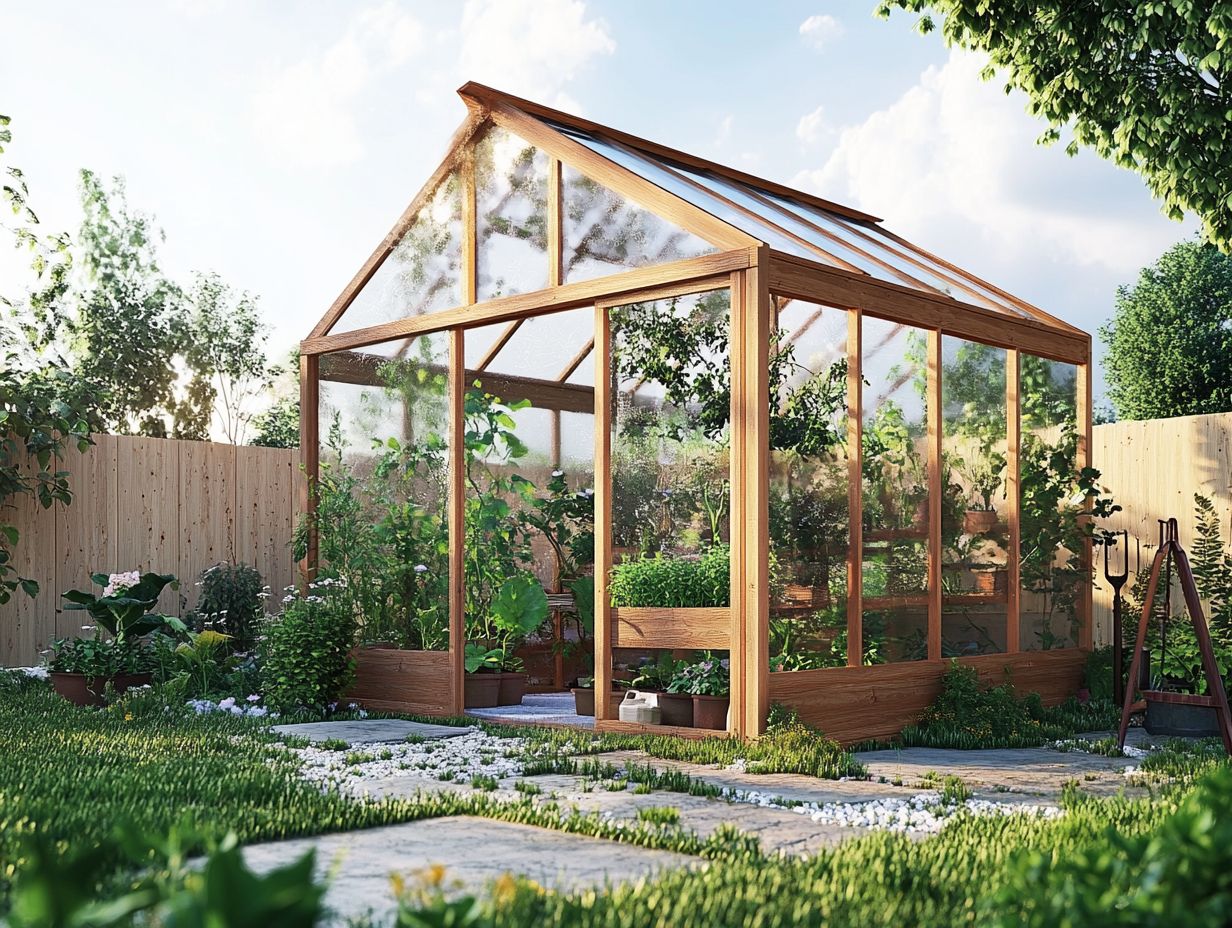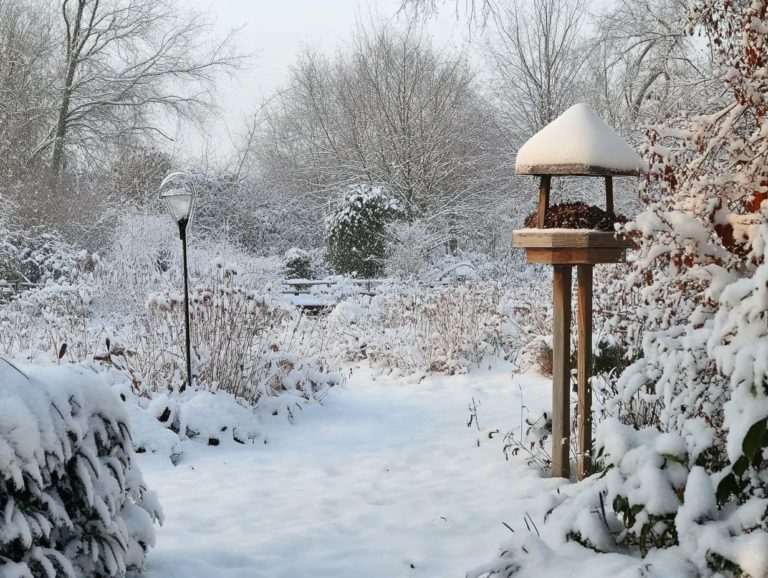How to Create Shelter for Sensitive Plants?
Creating a thriving garden filled with sensitive plants can be a wonderfully rewarding yet challenging endeavor. These delicate species demand your keen attention to flourish, as their well-being is influenced by their environment and genetic makeup.
This article delves into the various types of sensitive plants, highlighting the critical elements that affect their sensitivity. You’ll learn how to select and construct the ideal shelter for them, ensuring their comfort and growth. From choosing the right materials to maintaining those protective structures, you’ll discover alternative methods to help your plants thrive.
Let s explore how to care for these beautiful plants together!
Contents
- Key Takeaways:
- Understanding Sensitive Plants
- Factors Affecting Plant Sensitivity
- Choosing the Right Shelter
- Creating a Suitable Shelter
- Maintaining the Shelter
- Alternative Methods for Protecting Sensitive Plants
- Frequently Asked Questions
- What materials can effectively shelter your sensitive plants?
- How can I protect my young plants from harsh weather conditions?
- Is it necessary to create shelter for all types of plants?
- When is the best time to create shelter for sensitive plants?
- How do I properly set up shelter for sensitive plants?
- Can I use natural materials to create shelter for sensitive plants?
Key Takeaways:

- Select the right shelter for each plant.
- Regularly check and adjust your shelter for optimal protection.
- Explore natural or DIY methods to safeguard your plants.
Understanding Sensitive Plants
Understanding sensitive plants is vital for growing plants in winter, as these delicate specimens are especially susceptible to frost damage and the harsh realities of winter. They require your special attention, including tailored winter protection strategies such as mulching, which means covering the soil with organic material.
This creates a protective barrier against strong winds and the weight of snow. Knowing how to care for young plants and other sensitive species can greatly influence their health and survival during the colder months, ensuring they flourish beautifully come spring.
Types of Sensitive Plants
There are various types of sensitive plants that need your special attention during winter. Popular choices include rose bushes and hardy roses, along with delicate evergreens and young trees. Each plant has unique needs and weaknesses that you must address to ensure they survive the colder months.
For example, rose bushes often appreciate a generous layer of mulch to protect their roots from freeze-thaw cycles. Hardy roses might require a bit of pruning to remove any damaged canes.
Delicate evergreens are particularly prone to frost, so you’ll want to provide protective coverings or place them strategically to shield from harsh winds. Young trees, especially fruit varieties, should be wrapped to prevent bark splitting and to insulate their root systems.
Understanding these care requirements will help your plants thrive even in winter.
Factors Affecting Plant Sensitivity
Factors affecting plant sensitivity can be divided into environmental and genetic influences. Both play crucial roles in determining how resilient a plant will be against temperature fluctuations, frost, and potential diseases during the winter season.
Understanding these factors will empower you to make informed decisions to protect and nurture your plants effectively.
Environmental and Genetic Factors
Both environmental and genetic factors significantly influence a plant’s sensitivity. Conditions like frost and snow can increase a plant’s vulnerability to diseases.
Take soil composition, for instance; it profoundly impacts nutrient availability, which in turn affects overall plant health. Plants that thrive in loamy soils often show greater resilience, as they absorb essential nutrients more effectively. In contrast, overly sandy or clayey soils can create stress and susceptibility, particularly during harsh weather, such as late-spring frosts.
While snow accumulation can act as a protective insulating layer for roots against extreme cold, excessive snow may suffocate plants, especially if their genetic traits do not favor such conditions. By understanding these intricate dynamics, you can implement better management strategies that enhance both the environmental and genetic resilience of various plant species.
Choosing the Right Shelter

Selecting the ideal shelter for your fragile plants is crucial for their survival during winter. Consider options such as protective structures and cold frames, which serve as effective barriers against the harsh elements.
These solutions provide the necessary defense, ensuring your cherished plants thrive despite the cold.
Types of Shelters and Their Benefits
You have a variety of types of shelters at your disposal for your fragile plants, such as cold frames, protective structures, and even burlap wraps, that significantly enhance temperature regulation and frost protection.
Cold frames, typically constructed from wood and glass, allow sunlight to stream in while trapping warmth, creating a microclimate that can safeguard fragile vegetation against chilling temperatures.
Cloches, made of plastic or glass, can be placed directly over individual plants for targeted protection, helping to maintain the necessary warmth and humidity.
Tunnels, often fashioned from lightweight materials like polyethylene, offer a broader coverage area and foster a controlled environment for delicate seedlings.
These shelters minimize the risk of damage from harsh weather, enabling your fragile plants to thrive and flourish even under challenging conditions.
Creating a Suitable Shelter
When crafting an appropriate shelter for your fragile plants, it’s essential to thoughtfully select materials and techniques. Consider utilizing natural options such as burlap and stakes to build a sturdy shelter that stands up to winter weather.
This careful planning protects your plants and boosts their strength against the weather.
Materials and Techniques for Shelter Construction
When constructing shelters for your fragile plants, consider using natural materials like burlap, stakes, and conifer branches for an effective and environmentally-friendly solution.
These materials not only shield your plants from harsh weather but also foster healthier growth by allowing air circulation the movement of air, which helps keep plants healthy and sunlight to penetrate.
Burlap, which you can easily find at garden centers, serves as an excellent windbreak while retaining the moisture that your plants crave.
Wooden stakes provide the structural support needed to keep your shelter intact during storms.
Conifer branches, readily available from nearby forests or even your backyard, act as natural insulation, trapping warmth and further protecting your plants from frost.
By employing these techniques, you enhance the protective qualities of the shelter and adhere to sustainable gardening practices, promoting the health and vitality of your plants.
Maintaining the Shelter
Maintaining the shelter for your fragile plants is essential for seasonal care. It demands consistent attention and adjustments to ensure that the protective structure remains effective against the challenges of winter.
Regular Maintenance and Adjustments

Act now to keep your shelter intact through winter! Regular maintenance and adjustments to your protective barrier are essential for ensuring that your fragile plants thrive throughout the winter months, especially when it comes to managing air circulation and snow accumulation.
Regularly check your shelter for any damage. Adjusting the structure as needed is important to promote optimal air circulation, which reduces the risk of mold and ensures adequate ventilation.
Verifying that the barrier provides sufficient protection against frost is crucial, as sudden temperature drops can harm delicate foliage.
By keeping an eye on these factors, you not only safeguard your plants’ health but also maximize their growth potential during the colder season, ensuring that they burst forth with beauty and vitality come spring.
Alternative Methods for Protecting Sensitive Plants
For gardeners like you who are exploring alternative methods to safeguard fragile plants, natural and DIY solutions present effective strategies for winter protection. These approaches allow you to enhance your garden s resilience without solely depending on commercial products.
Start building your shelter today, and give your plants the protection they deserve!
Natural and DIY Solutions
Natural and DIY solutions protect sensitive plants. Methods include using mulch, burlap wraps, and careful planting to enhance winter protection.
By implementing these strategies, you can create a small area with a different climate that shields your fragile greenery from harsh weather conditions. For instance, applying a thick layer of organic mulch retains soil moisture and serves as an insulating barrier, helping to moderate temperature fluctuations. Burlap wraps can be employed to protect tender plants from wind and frost while allowing essential sunlight to filter through.
Planting more resilient species around delicate ones creates a protective buffer, reducing wind exposure and providing much-needed shade. Each approach offers immediate benefits and long-term advantages. Understanding their unique applications gives you the power to thrive in your gardening endeavors!
Frequently Asked Questions
What materials can effectively shelter your sensitive plants?
You can use materials such as floating row covers, frost blankets, straw, burlap, or even old bed sheets to create shelter.
How can I protect my young plants from harsh weather conditions?

To protect your young plants, create a shelter using materials like shade cloth, plastic sheeting, or even a makeshift greenhouse.
Is it necessary to create shelter for all types of plants?
No, not all plants require shelter. Sensitive plants, such as young seedlings or tropical plants, may need extra protection from extreme weather conditions.
When is the best time to create shelter for sensitive plants?
The best time to create shelter for sensitive plants is before harsh weather conditions are expected, such as strong winds, heavy rain, or frost.
How do I properly set up shelter for sensitive plants?
To set up shelter for sensitive plants, ensure the material is securely anchored in the ground and covers the entire plant. Leave enough space for air circulation and remove the shelter when the weather improves.
Can I use natural materials to create shelter for sensitive plants?
Yes, you can use natural materials such as tree branches, leaves, or even a straw bale. Just make sure they are properly anchored and provide enough protection for the plants.






